

| 日本語モード |
| [Introduction] [News] |


| 日本語モード |
| [Introduction] [News] |
**Happy New Year**
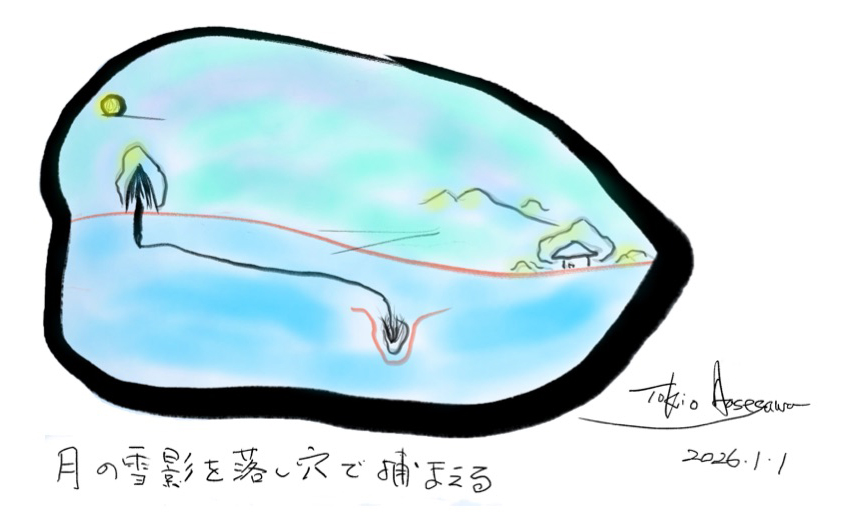
The final event place of last year’s *STONE MUSIC* lectures and performances in India
―marking the third consecutive year―was held at the hall of a Warli village.
Ghorkhana san performed stone performance, Vijay san performed bamboo,
and Sadashiv san performed Shadow-Pulling performance.
After the performance, the entire village presented the Tarpa dance in the post-harvest square.
This traditional dance will be unveiled for the first time worldwide at “Namaste India 2026.”
Let’s hope it comes to fruition.
I look forward to your continued support in the coming year.
Wishing everyone good health and happiness.
January 1, Reiwa 8 (2026)
Tokio Hasegawa
News
ECfilm screening + panel discussion Indian Mithila Art and Women
will held at Ntional Film Archive of Japan on February 29,2020.
Please see here for the detail.
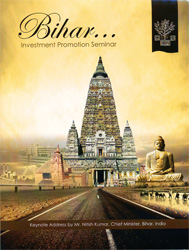 Mithila Museum was introduced in the brochure distributed at a Indian Bihar Prime Minister Mr. Nitish Kumar investment seminar held at Embassy of India, Tokyo on February 20, 2018.
Mithila Museum was introduced in the brochure distributed at a Indian Bihar Prime Minister Mr. Nitish Kumar investment seminar held at Embassy of India, Tokyo on February 20, 2018.
In addition, the Embassy gathered up the activity of Mithila Museum and NPO Society to Promote India-Japan Cultural Relations for the press for visiting to Japan of Bihar Prime Minister.
The press is as the follow.
------
Embassy of India Tokyo
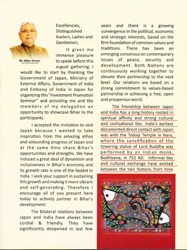 The Mithila Museum is housed in a converted schoolhouse in Tokamachi, Niigata Prefecture, situated in Japan's snow country. It contains permanent exhibits of approximately 2,000 Mithila artworks, of which, more than 300 paintings were created by the Mithila artists in Japan, Warli paintings by an aboriginal group in India, and Indian terracotta statues and figurines. Notable pieces in the collection include 36 original works by the late Ganga Devi, Padma Shri considered as one of the foremost masters of Mithila/Madhubani painting. Also, the core of the terracotta collection is the 109-piece donation made in 1989 by the Government of India. The Mithila art collection, which was created to contain the diaspora of this art form, is recognized by the Government of India for its breadth and quality. The Museum focuses its activities on the acquisition, research, and publicity of Mithila paintings, a free school using the surrounding natural forest as a backdrop, and provision of a forum for international understanding. All its cultural activities are based on a cosmic outlook on time and space. The Mithila Museum has openings for short term and long term volunteers. Participants in the Museum's activities have a first-hand chance to learn from the unique artists who regularly come to Japan to exhibit and create their artwork.
The Mithila Museum is housed in a converted schoolhouse in Tokamachi, Niigata Prefecture, situated in Japan's snow country. It contains permanent exhibits of approximately 2,000 Mithila artworks, of which, more than 300 paintings were created by the Mithila artists in Japan, Warli paintings by an aboriginal group in India, and Indian terracotta statues and figurines. Notable pieces in the collection include 36 original works by the late Ganga Devi, Padma Shri considered as one of the foremost masters of Mithila/Madhubani painting. Also, the core of the terracotta collection is the 109-piece donation made in 1989 by the Government of India. The Mithila art collection, which was created to contain the diaspora of this art form, is recognized by the Government of India for its breadth and quality. The Museum focuses its activities on the acquisition, research, and publicity of Mithila paintings, a free school using the surrounding natural forest as a backdrop, and provision of a forum for international understanding. All its cultural activities are based on a cosmic outlook on time and space. The Mithila Museum has openings for short term and long term volunteers. Participants in the Museum's activities have a first-hand chance to learn from the unique artists who regularly come to Japan to exhibit and create their artwork.
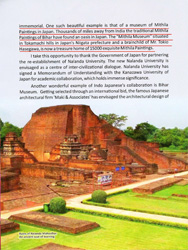 Mr. Tokio Hasegawa, founder and director of Mithila Museum and Chairman of NPO society to promote India-Japan Cultural Relations founded the Mithila Museum in 1982. He has also been involved in organizing the Namaste India which showcases Indian dance, music, food, tourism, handicrafts every year in Tokyo for the past 25 years. Between 1993 and 2004, the event was jointly organised by the Japan Chamber of Commerce and Industry and the Japan-India Business Co-operation Committee with support from Mr Hasegawa. From 2005 onwards, Mr Hasegawa has acted as the head organiser of the event. The festival is said to be the largest of its kind outside of India, attracting upwards of 200,000 people annually. has also organised local tours for incoming ICCR cultural troupes in various locations throughout Japan. Mr Hasegawa also helped the Embassy in organizing the Artist in Residence programme along with Telangana Art Trust in August 2015 and the Exhibition of Buddhist sculptures from Kolkata National Museum at the Tokyo National Museum in March-May 2015. He organised the participation of 33 cultural people –performers and artisans from Japan in the Surajkund Kund Mela in 2016.
Mr. Tokio Hasegawa, founder and director of Mithila Museum and Chairman of NPO society to promote India-Japan Cultural Relations founded the Mithila Museum in 1982. He has also been involved in organizing the Namaste India which showcases Indian dance, music, food, tourism, handicrafts every year in Tokyo for the past 25 years. Between 1993 and 2004, the event was jointly organised by the Japan Chamber of Commerce and Industry and the Japan-India Business Co-operation Committee with support from Mr Hasegawa. From 2005 onwards, Mr Hasegawa has acted as the head organiser of the event. The festival is said to be the largest of its kind outside of India, attracting upwards of 200,000 people annually. has also organised local tours for incoming ICCR cultural troupes in various locations throughout Japan. Mr Hasegawa also helped the Embassy in organizing the Artist in Residence programme along with Telangana Art Trust in August 2015 and the Exhibition of Buddhist sculptures from Kolkata National Museum at the Tokyo National Museum in March-May 2015. He organised the participation of 33 cultural people –performers and artisans from Japan in the Surajkund Kund Mela in 2016.
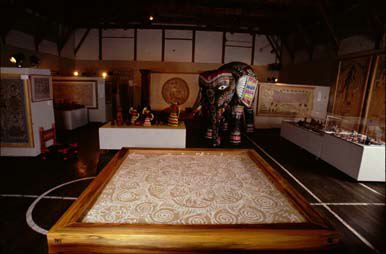 The Mithila Museum is housed in a converted schoolhouse in Tokamachi,
Niigata Prefecture, situated in Japan's snow country. Here
approximately 850 Mithila paintings, more than 300 paintings that the
Mithila artists created in Japan, Warli paintings by an aboriginal
group in India, and Indian teracotta statues and figurines, are
exhibited on a permanent basis.
The Mithila Museum is housed in a converted schoolhouse in Tokamachi,
Niigata Prefecture, situated in Japan's snow country. Here
approximately 850 Mithila paintings, more than 300 paintings that the
Mithila artists created in Japan, Warli paintings by an aboriginal
group in India, and Indian teracotta statues and figurines, are
exhibited on a permanent basis.
The core of the teracotta collection is the 109-piece donation
made in 1989 by the Government of India. The Mithila art collection,
which was created to contain the diaspora of this art form, is
recognized by the Government of India for its breadth and
quality.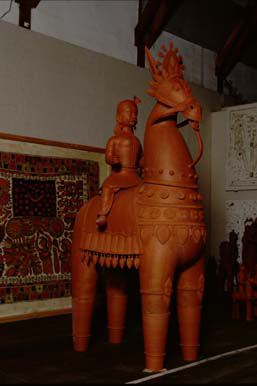
The Museum focuses its activities on the acquisition, research, and publicity of Mithila paintings, a free school using the surrounding natural forest as a backdrop, and provision of a forum for international understanding. All its cultural activities are based on a cosmic outlook on time and space.
Since 1988, when the world renowned Mithila artist Ganga Devi came to Japan, the Mithila Museum has invited various painters of Mithila art to Japan, and have asked the painters to practice their art form using traditional methods on a new material the Museum has developed. This material we call "pseudo wall." These paintings, using traditional bamboo stencils and natural pigments, synthesizes the naive and quiet magnitude of the traditional wall paintings with the contemporary, thus creating a totally independent and unique world of its own -- a world which we describe as "the cosmology of prayer."
Unlike in the native environment where these paintings are drawn, in Japan the Mithila and Indian aboriginal group artists create their art in an environment where a higher degree of refinement and creativity is possible. The Museum continues to add to its collection these new paintings created in Japan, giving each artist an opportunity for artistic growth.
The Mithila Museum has openings for short term and long term volunteers. Participants in the Museum's activities will have a first hand chance to learn from the unique artists creating the Warli and Dokra Indian aboriginal artists, and Mithila artists, who regularly come to Japan to exhibit and create their artwork.
We have the following openings:
The Museum regularly maintains a traveling exhibition. Among other things, volunteers would be required to man the reception and gift stalls, scheduling the artists' itinerary, and attending to the personal needs of the artists.
The Museum requires among other things, volunteers to help out in the fields, and help out in creating databases and home pages with the PC.
Notice on Operating Hours and Admission Charges
Students 300yen per person
Ooike, Tokamachi-shi, Niigata Pref. 948, Japan
Phone +81 (0)257-52-2396/Fax+81 (0)257-52-6076
E-mail: info@mithila-museum.com
(c) Copyright 1996/2005 Mithila Museum.All rights reserved.